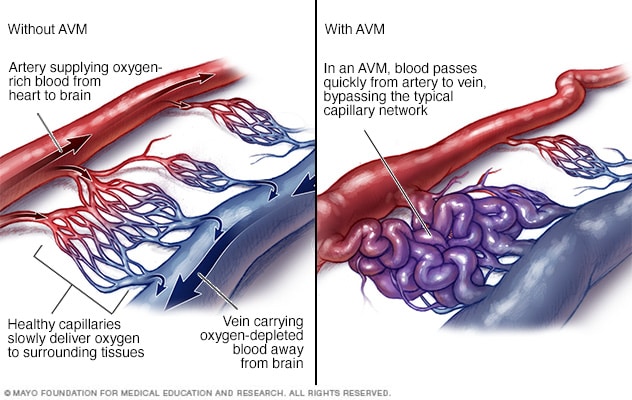Overview
AVM blood flow

AVM blood flow
In an arteriovenous malformation, also known as an AVM, blood passes quickly from an artery to a vein, disrupting the usual blood flow and depriving the surrounding tissues of oxygen.
An arteriovenous malformation, also known as an AVM, is a tangle of blood vessels that creates irregular connections between arteries and veins. This disrupts blood flow and prevents tissues from receiving oxygen. An AVM can occur anywhere in the body, including in the brain.
Arteries move oxygen-rich blood from the heart to the brain and other organs. Veins drain the oxygen-depleted blood back to the lungs and heart. When an AVM disrupts this critical process, surrounding tissues might not get enough oxygen.
Because the tangled blood vessels in an AVM do not form properly, they can weaken and burst. If an AVM in the brain bursts, it can cause bleeding in the brain, which can lead to a stroke or brain damage. Bleeding in the brain is known as a hemorrhage.
Read more about brain AVM (arteriovenous malformation).
The cause of AVMs is not clear. Rarely, they are passed down in families.
Once diagnosed, a brain AVM often can be treated to prevent or reduce the risk of complications.
Products & Services
Symptoms
Symptoms of an arteriovenous malformation, also known as an AVM, can vary. Sometimes an AVM doesn't cause symptoms. The AVM can be found while getting images for another health concern.
Often the first symptoms appear after bleeding occurs. Besides bleeding, symptoms can include:
- Trouble with thinking that gets worse over time.
- Headaches.
- Nausea and vomiting.
- Seizures.
- Loss of consciousness.
Other possible symptoms include:
- Weak muscles, such as weakness in the legs.
- Loss of movement and feeling in one part of the body, known as paralysis.
- Loss of coordination that can cause trouble with walking.
- Trouble doing tasks that require planning.
- Back pain.
- Dizziness.
- Vision problems. This may include losing part of the field of vision, trouble moving the eyes or swelling of part of the optic nerve.
- Trouble with speech or understanding language.
- Numbness, tingling or sudden pain.
- Memory loss or dementia.
- Seeing or hearing things that aren't there, known as hallucinations.
- Confusion.
Children and teens might have trouble with learning or behavior.
One type of AVM called a vein of Galen malformation causes symptoms that appear at or shortly after birth. A vein of Galen malformation occurs deep inside the brain. Signs can include:
- A buildup of fluid in the brain that causes the head to be larger than usual.
- Swollen veins on the scalp.
- Seizures.
- Failure to thrive.
- Congestive heart failure.
When to see a doctor
Seek medical attention if you have any of the symptoms of an AVM, such as headaches, dizziness, vision problems, seizures and changes in thinking. Many AVMs are found during testing for a different condition, such as during a CT scan or an MRI.
Causes
An arteriovenous malformation happens when arteries and veins connect in an irregular way. Experts don't understand why this happens. Certain genetic changes might play a role, but most types are not usually passed down in families.
Risk factors
Rarely, having a family history of an arteriovenous malformation can increase your risk. But most types aren't inherited.
Certain hereditary conditions can increase your risk of an arteriovenous malformation. These include hereditary hemorrhagic telangiectasia, also known as Osler-Weber-Rendu syndrome.
Complications
The most common complications of an arteriovenous malformation are bleeding and seizures. Bleeding can cause brain damage and may cause death if you don't get treated.
Nov. 13, 2024